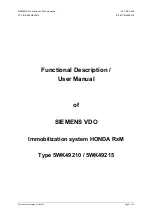
CS-8
How do I check for a cracked heat exchanger?
Visual inspection of the heat exchanger should always
be done first. It may not be possible with visual inspec-
tion alone to make sure that the heat exchanger has no
cracks or pinhole leaks caused by corrosion.
One sign of a cracked heat exchanger is a change of
oxygen concentration in the flue gases of greater than
1/2% oxygen, or a change in the carbon monoxide
level greater than 25 ppm. This change is measured by
comparing readings before and after the circulation
blower has turned on. For this test to be valid, CO lev-
els must be present in flue gas.
Although some cracks may be seen with visual inspec-
tion alone, the method described above can be used to
find “invisible” cracks or cracks that may expand as the
furnace heats up.
CS-9
What’s the relationship between indoor air
quality (IAQ) and combustion safety?
Good, efficient combustion is safe combustion: safe
combustion maintains good indoor air quality.
CS-10 What are the most common chimney
problems?
Simple blockages caused by birds nests, chimney dete-
rioration, soot build-up and other “natural” occur-
rences restrict the air flow through the combustion
equipment and can cause incomplete, inefficient com-
bustion which will produce dangerous levels of toxic
gases which could infiltrate the living/working area.
High levels of moisture in chimneys can cause the lining
materials to decompose, creating restrictions which
reduce the ability of the chimney to draw sufficient air
to assure efficient, safe combustion.
Performing draft measurements will allow you to be
sure that the chimney has vented flue gases to the out-
side air.
CS-11 How does inadequate ventilation increase the
hazard of CO?
Weathertight homes and increased use of exhaust fans
will create a negative pressure within a home.
Negative pressure conditions and blocked flue stacks
can result in combustion appliance backdraft into the
living areas.
Also, weathertight homes may have insufficient fresh
air to support complete combustion, producing CO.
E N V I R O N M E N TA L
EC-1
How important is it to measure NO
X
, SO
2
, and
CO for environmental compliance?
If your local regulatory authorities require measurement
of these gases, it is very important to comply. Non-
compliance (ignoring these gases) could result in fines,
penalties and eventually, the shutdown of your equip-
ment.
Air quality regulations vary from state-to-state and
from region-to-region.
Contact your EPA office or state environmental office
for the most current information about the specific
environmental regulations which affect you.
Because regulations change, and new regulations are
always being written into law, you should check at least
twice a year with the EPA and/or DER to make sure that
you are in compliance with current regulations.
EC-2
Is it difficult to convert ppm gas measure-
ments to other units of measurements?
Other units of measurement are used to determine the
weights of each of the pollutants for an amount of each
fuel burned. Sometimes regulations are written which
include these other units of measurement.
Chart #11 below, will allow you to easily convert ppm
to other units of measurement.
7
Chart 11
P O L L U TA NT CO N VE R S I O N S
To convert from ppm to any of the units below, multiply ppm by
the number in the correct column and ro w.
Fuel
Pollutant
LB/MBTU
MG/NM3
MG/KG
G/GJ
NAT GAS
CO
0.00078
1.249
12.647
0.338
NAT GAS
NO
X
0.00129
2.053
20.788
0.556
NAT GAS
SO
2
0.00179
2.857
28.949
0.775
OIL (#2, #6)
CO
0.00081
1.249
15.118
0.354
OIL (#2, #6)
NO
X
0.00134
2.053
24.850
0.582
OIL (#2, #6)
SO
2
0.00186
2.857
34.605
0.811
COAL
CO
0.00107
1.249
27.178
0.460
COAL
NO
X
0.00167
2.053
42.418
0.718
COAL
SO
2
0.00233
2.857
59.1847
1.000
Definitions:
All numbers apply to values as corrected to 3% excess Oxygen (6% for coal)
and dry gas.
LB/MBTU: pounds of pollutants per Million BTU (British Thermal Unit)
MG/NM3: milligrams of pollutant per Normal cubic meter of gas sampled
MG/KG: milligrams of pollutant per Kilogram of fuel burned
G/GJ: grams of pollutant per GigaJoule (10
9
Joule)
































